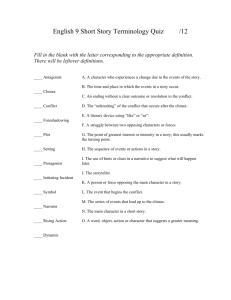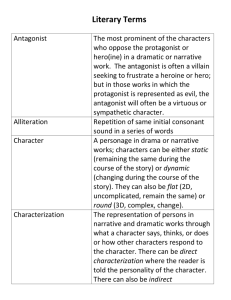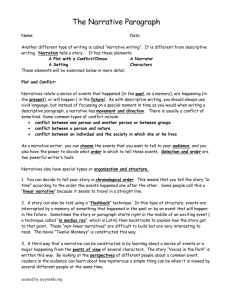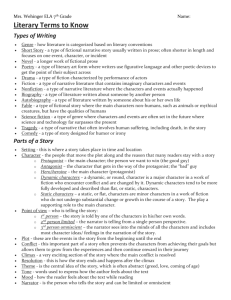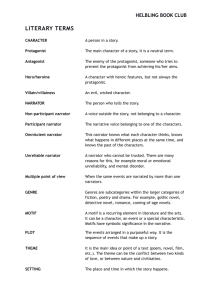The particular arrangement of actions, events, and situations that
advertisement
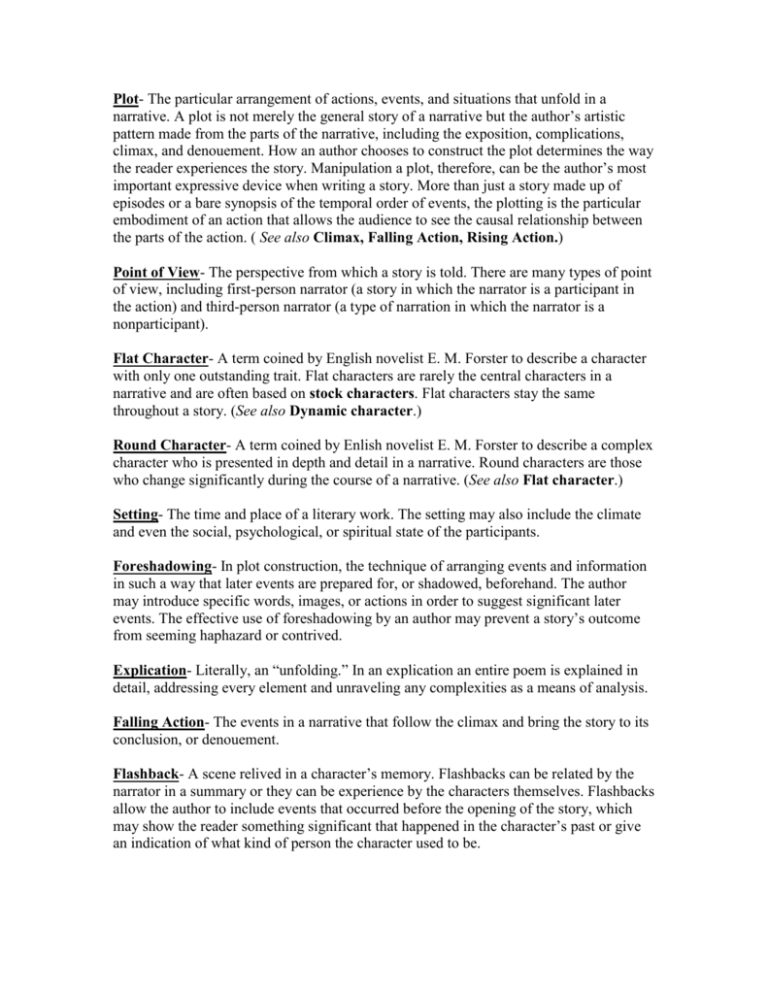
Plot- The particular arrangement of actions, events, and situations that unfold in a narrative. A plot is not merely the general story of a narrative but the author’s artistic pattern made from the parts of the narrative, including the exposition, complications, climax, and denouement. How an author chooses to construct the plot determines the way the reader experiences the story. Manipulation a plot, therefore, can be the author’s most important expressive device when writing a story. More than just a story made up of episodes or a bare synopsis of the temporal order of events, the plotting is the particular embodiment of an action that allows the audience to see the causal relationship between the parts of the action. ( See also Climax, Falling Action, Rising Action.) Point of View- The perspective from which a story is told. There are many types of point of view, including first-person narrator (a story in which the narrator is a participant in the action) and third-person narrator (a type of narration in which the narrator is a nonparticipant). Flat Character- A term coined by English novelist E. M. Forster to describe a character with only one outstanding trait. Flat characters are rarely the central characters in a narrative and are often based on stock characters. Flat characters stay the same throughout a story. (See also Dynamic character.) Round Character- A term coined by Enlish novelist E. M. Forster to describe a complex character who is presented in depth and detail in a narrative. Round characters are those who change significantly during the course of a narrative. (See also Flat character.) Setting- The time and place of a literary work. The setting may also include the climate and even the social, psychological, or spiritual state of the participants. Foreshadowing- In plot construction, the technique of arranging events and information in such a way that later events are prepared for, or shadowed, beforehand. The author may introduce specific words, images, or actions in order to suggest significant later events. The effective use of foreshadowing by an author may prevent a story’s outcome from seeming haphazard or contrived. Explication- Literally, an “unfolding.” In an explication an entire poem is explained in detail, addressing every element and unraveling any complexities as a means of analysis. Falling Action- The events in a narrative that follow the climax and bring the story to its conclusion, or denouement. Flashback- A scene relived in a character’s memory. Flashbacks can be related by the narrator in a summary or they can be experience by the characters themselves. Flashbacks allow the author to include events that occurred before the opening of the story, which may show the reader something significant that happened in the character’s past or give an indication of what kind of person the character used to be. First person narrator- A story in which the narrator is a participant in the action. Such a narrator refers to himself or herself as “I” and may be a major or minor character in the story. His or her attitude and understanding of characters and events shapers the reader’s perception of the story being told. Epiphany- A moment of insight, discovery, or revelation by which a character’s life is greatly altered. An epiphany generally occurs near the end of a story. The term, which means “showing forth” in Greek, was first used in Christian theology to signify the manifestation of God’s presence in the world. This theological idea was first borrowed by James Joyce to refer to a heightened moment of secular revelation. Epigraph- A brief quotation preceding a story or other literary work. An epigraph usually suggests the subject, theme, or atmosphere the story will explore. Dynamic character- A character who, during the course of the narrative, grows or changes in some significant way. (See also Character development.) Complication- The introduction of a significant development in the central conflict in a drama or narrative between characters (or between a character and his or her situation). Traditionally, a complication begins the rising action of a story’s plot. Dramatic conflict (motivation versus obstacle) during the complication is the force that drives a literary work from action to action. Complications may be external or internal or a combination of the two. A fateful blow such as illness or an accident that affects a character is a typical example of an external complication—a problem the characters cannot turn away from. An internal complication, in contrast, might not be immediately apparent, such as the result of some important aspect of a character’s values or personality. Conflict- In Greek, agon, or contest. The central struggle between two or more forces in a story. Conflict generally occurs when some person or thing prevents the protagonist from achieving his or her intended goal. Opposition can arise from another character, external events, preexisting situations, fate, or even some aspect of the main character’s own personality. Conflict is the basic material out of which most plots are made. (see also Antagonist, Character, Complication, Rising action.) Character- An imagined figure inhabiting a narrative or drama. By convention, the reader or spectator endows the fictional character with moral, dispositional and emotional qualities expressed in what the character says—the dialogue—and by what he or she does—the action. What a character says and does in any particular situation is motivated by his or her desires, temperament, and moral nature. (See also Dynamic character and Flat character) Character Development- The process in which a character is introduced, advanced, and possibly transformed in a story. This development can prove to be either static (the character’s personality is unchanging throughout the narrative) or dynamic (the character’s personality undergoes some meaningful change during the course of the narrative). (See also Dynamic character.) Antihero- A protagonist who is lacking in one or more of the conventional qualities attributed to a hero. Instead of being dignified, brave, idealistic, or purposeful, for instance, the antihero may be buffoonish, cowardly, self-interested, or weak. The antihero is often considered an essentially modern form of characterization, a satiric or frankly realistic commentary on traditional portrayals of idealized heroes or heroines. Modern examples range from Kafka’s many protagonists to Beckett’s tramps in Waiting for Godot. Antagonist- The most significant character or force that opposes the protagonist in a narrative or drama. The antagonist may be another character, society itself, a force of nature, or even—in modern literature—conflicting impulses within the protagonist. Protagonist- The central character in a literary work. The protagonist usually initiates the main action of the story, often in conflict with the antagonist. (See also Antagonist.) Limited-omniscience- Also called third-person limited point of view. A type of point of view in which the narrator sees into the mind of some but not all of the characters. Most typically, limited omniscience sees through the eyes of one major or minor character. In limited omniscience, the author can compromise between the immediacy of first-person narration and the mobility of third person. Omniscient narrator- Also called all-knowing narrator. A narrator who has the ability to move freely through the consciousness of any character. The omniscient narrator also has complete knowledge of all the external events in a story. (See also Nonparticipant narrator.) Words not listed on guide: Climax- The moment of greatest intensity in a story, which almost inevitably occurs toward the end of the work. The climax often takes the form of a decisive confrontation between the protagonist and antagonist. In a conventional story, the climax is followed by the resolution or denouement in which the effects and results of the climactic action are presented. (See also Falling action, Rising action.) Rising action- That part of the play or narrative including the exposition, in which events start moving toward a climax. In the rising action the protagonist usually faces the complications of the plot to reach his or her goal. In Hamlet, the rising action develops the conflict between Hamlet and Claudius, with Hamlet succeeding in controlling the course of events. Because the mainspring of the play’s first half is the mystery of Claudius’s guilt, the rising action reaches a climax when Hamlet proves the kings guilt by the device of the plat within a play (3.2—the “mousetrap” scene), when Hamlet as a heroic avenger has positive proof of Claudius’s guilt. Nonparticipant narrator- A narrator who does not appear in the story as a character but is capable of revealing the thoughts and motives of one or more characters. A nonparticipant narrator is also capable of moving from place to place in order to descrive action and report dialogue. (See also Omniscient narrator.)
